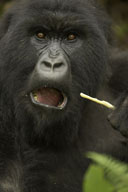
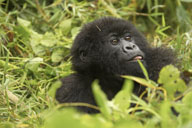
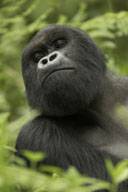
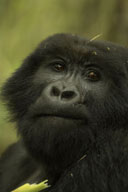




Almost exactly one year ago Mary and I and a small group of friends
'scouted out' Rwanda, photographing the mountain gorillas of Volcanoes
National Park for the first time. If you read our scouting
report , you know we had an extremely positive experience.
In fact, Ken Benson, one of our participants, just won
the NATURE'S BEST Photography annual photo contest in the Endangered
Species category with an image made on the last day of last year's
trip! Congrats, Ken. This year we did our first 'official' photo
tour, and the second time around it was even better.
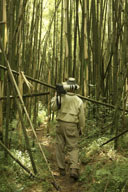
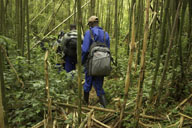
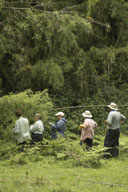
Caption: Except for hiking sticks, gorilla trekkers carrying nothing as they're hiking to and from the gorillas. Local Rwandans act as porters, carrying our camera packs, tripods, and anything else. Once we're at the gorillas photographers gather up whatever gear they're expecting to use, including their tripods, and follow the trackers the few dozen feet to the gorillas.
Why? Probably the best reason was that we were simply better
prepared - we knew what to expect on the hikes, and we knew what
the shooting conditions would be like once we encountered the
gorillas. Consequently, at least for Mary and I, there was some
measure of calm and matter-of-factness as we went about our business
of photographing the gorillas. At least for us ….
Although we thoroughly prepared and prepped our participants,
I doubt if anything can truly prepare one for the excitement -
the pure adrenaline rush of being close to gorillas in their habitat
for the first time. Or the fifth, for that matter, as we visited
the gorillas on five trips.
Like last year's scouting trip we paid for five gorilla treks.
Each trek lasts several hours, highlighted, of course, by the
one-hour visit with a gorilla group. One hour doesn't seem like
a very long time when you're contemplating traveling to east-central
Africa to see a single species, but the experience is worth it.
In reality, one quality hour with any wild animal is a fairly
long time-our encounters with African leopards can sometimes be
measured in seconds, yet are unforgettable and intense, and the
hour offers incredible opportunities if luck is with us.
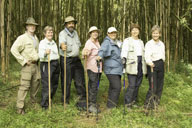
Caption: Our gorilla group, left to right: Joe, Ellen Goff, Bill and Sarah Plunkett, Kathy Morris, Margie White, and Mary Ann.
We opted for five visits because conditions can vary so greatly,
and while a single visit might be enough if luck is with you,
even five visits might not be enough if luck was totally against
you! By visiting the gorillas five times we had the option of
visiting all five habituated gorilla groups, of maximizing our
chances of encountering the gorillas in favorable shooting conditions,
and of getting them in good light.
Ideally, one hopes to find the gorillas in an open clearing in
slightly overcast light - ideally 'cloudy bright,' the perfect
mammal portraiture light. In completely open conditions bright
sunlight can work, but the contrast extremes can be difficult,
and gorillas just look best under soft light. In the forest, bright
sunlight makes extremely difficult shooting conditions, as contrasty
shadows make exposures a nightmare.
Ideally, two, one hopes to find the gorillas quickly, unless one
enjoys hiking uphill or slogging along on muddy trails for hours
on end. In the summer dry season, mountain gorillas may migrate
to the near top of the volcanoes, and some treks start long before
dawn and return hours after sunset! No thanks - I'd rather not
work that hard.
Finally, one hopes to find the gorillas during their siesta period,
the few hours after their first morning feeding when they sit
and relax and play before wandering off for another feeding.
Those are the conditions we hoped for, and, like last year, we
struck gold in some variation on all five encounters. The first
was the toughest - we were told the gorillas were not too far
away and our guides suggested that we do an easy trail for the
newcomers. This easy trail involved a 2 mile or so walk, generally
uphill, through Rwandan farms before we entered the stone-fenced
boundary of the park itself. The first group was in fairly tight
quarters - at least tighter than some in our group expected, and
coupled with working through vegetation, trying to get set up,
and dealing with the light, it was a challenge.
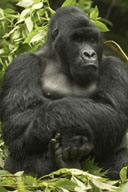
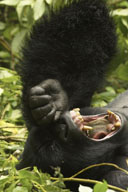
But what a first encounter! If you had read my Outdoor Photographer
column on the mountain gorillas, you might remember the visit
we had with 'the mountain king,' a silverback that sat in a small
clearing as we, his supplicants, came forward and kneeled before
him. That experience was the culmination of that year's scouting
trip - this year, a similar experience was our first encounter!
Our silverback sat and watched us for a few minutes, then got
up, beat its chest, and stormed off through the bamboo. Minutes
later he was back, returning to his post where he laid down, stretched,
and gave us a wonderful show.
Frankly, I thought it was a great shoot - I'd been on worse, believe
me, but it was a tough start that did intimidate a few of our
hikers, as they now worried if this was an easy trek, what would
the rest be like? Thinking back, there were some tough moments.
At one point the gorillas we were following changed direction,
and since Mary and I were last in the column our guide pointed
us to a short cut to reach the gorillas. I had proceeded about
twenty feet when I heard Mary give a yelp - she had stepped into
a vegetation covered gulley and her leg went through the vines,
banging her knee. For a few seconds, she worried that her leg
had been broken, and, to almost make it even worse, as I ran back
to help her, I stepped into another hidden ravine and plunged
forward as well. Fortunately neither of us broke anything, although
Mary's leg was banged up and sore for the rest of the time we
were in Rwanda.
Skies were great, with clouds and overcast and occasional light
rain, and in the distance, as we packed up for our hike back to
our vehicle thunder rumbled. By the time we reached the farm fields
it had begun raining in earnest, and as we completed the last
third of our trek a driving, blasting storm drove horizontal sheets
of rain, soaking us to the skin. Again, I'd seen worse, but for
the new people?
When we returned to our lodge the staff collected our wet clothes
and boots, and began the drying process for the next day's trek.
We had a near panic that evening when the lodge manager told us
our clothes would be ready the following afternoon! We got that
corrected, and the next day's shoot began without a hitch.
Each day got progressively easier, both in the fitness level of
the participants and in the circumstances of the shoot. Most hikes
began at around 8000 feet (give or take 200 feet or so), and elevation
gains for some treks went as high as almost 900 feet. For 'flatlanders'
that takes some getting used to, but by day 5 everyone was in
great shape and well conditioned.
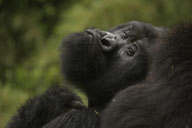
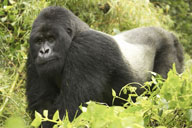
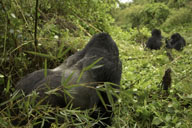
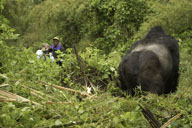
Caption: LEFT. Wide-angle views may best capture the essence of the experience, but they're difficult to do. I was using a 28-300mm f4.5-5.6 lens on one camera body, and a 120-300 2.8 on another. It was difficult to use two cameras in the heavy vegetation, and on this day I elected to just use the 28-300. Fortunately, the troop walked closeby and I got this over-the-shoulder, 'gorilla's eye' view of the troop. RIGHT: Ellen and one of our guides as the silverback passed by.
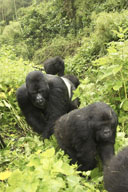
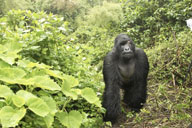
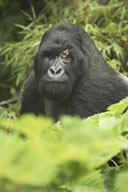
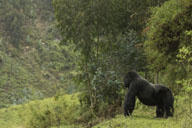
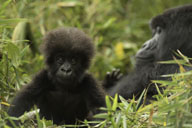
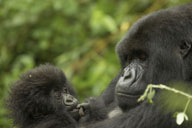
Caption: A black-backed stares out across the fields edging its habitat. One hundred yards away a cluster of Rwandan farmers stood watching, fascinated by this rare glimpse of their forest neighbors. Two of three babies from our third day.
On day three we visited the largest group, over thirty individuals, with one female raising two infant twins! This is an almost unheard-of event, but we had opportunities to photograph the mother and one of her babies several times. The experience was good, but it could have been great, since our 'lead guide' had an entirely different attitude and level of helpfulness than that of our usual gorilla guide. Fortunately he accompanied us as well, and he helped make the shoot a rewarding one. The trek was a relatively short one - we found our first gorillas at the edge of the farm fields outside the park boundary! Some of our favorite shots, in fact, shows a black-backed male standing on all fours looking out across the fields - an emblematic image of shrinking critical habitat.
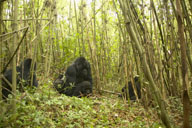
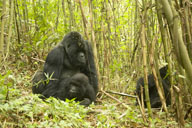
In many ways day four was the most difficult, as the gorillas
spent most of their time in fairly thick bamboo. The hike was
a short one, but the shooting conditions were tight. Still, we
had some of our most arresting images that day, as we had close
up, intimate views of the gorillas feeding on bamboo, and we 'voyeurized'
as the silverback grabbed a young female (gorilla, not from our
group!) and proceeded to mate. A rather awkward, lengthy affair
where he basically dragged her about the clearing, only yards
in front of us.
Like last year, we finished our gorilla treks by revisiting our
favorite group, and just like last year, everything worked. The
lighting was great - the sun was actually shining when we first
approached the gorillas, but quickly glazed over to a cloudy brightness
as the shooting got serious. A mother and newborn performed wonderfully,
giving us incredible interaction, and, at the end of the shoot,
we encountered the silverback again, sitting completely in the
open, basking in the soft light. As we left, our trail passed
the mid-morning nests of several other gorillas, who sat and calmly
watched us as we trailed by, thinking any one of the poses we
were now seeing would have been our highlight on our first day!
What an ending!
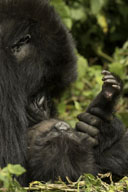
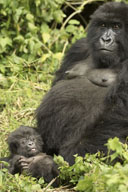
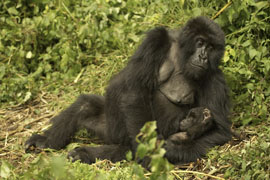
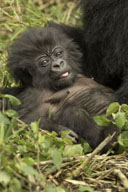
Two of our group had been with us on our first Kenya safari
(which preceded the gorilla trip) and left us; while the three
others in our group continued to our next destination, a scouting
trip to the Nyungwe Forest for monkeys. This forest, the largest
mountain forest in existence in central Africa, is home to several
monkey species, including troops of 400 or more colobus monkeys.
The landscape possibilities are great - fog-shrouded hillsides
framed by fern-draped trees, rolling ridges and silhouetted jungle
growth, but foolishly, instead of simply concentrating upon the
landscapes we elected to see the big colobus monkey troop which,
we were told, was a short hike. It was a bright, extremely clear
morning, and the hoped-for fog we needed for neat landscapes never
materialized.
We expected to hike for about three hours, on trails, we were
told, where the vegetation would never touch us - the paths were
that well worn and the trail so easy. Well, that's what a scouting
trip is for! We started our hike at the TOP of the mountains,
and hiked downhill, essentially, for 1,400 feet. Our three hour
hike ended up as six, and, when we finally arrived at the monkeys,
we had to go off trail, bushwhacking nearly straight down ravines
where we clutched vines and trees for support as we tried to get
close to the monkeys.
The group was supposed to be habituated, which in primate terms
must mean 'tolerant' of people, for they were by no means tame.
Fortunately we had elected to just bring binoculars and bird-watch
and monkey-view, and we were all glad we did, as there were virtually
no shooting opportunities, and viewing, in truth, was poor.
Watching the time, I knew we had to get back if we still hoped
to see the Genocide Memorial on the way back to Kigali, so we
left the monkeys and began our scramble back up the ravine, bushwhacking
through the jungle until we reached the main trail, where we continued
our ascent the 1,400 feet back to the trailhead! Although we all
were tired, and a bit tired of the long walk itself, everyone
had a huge sense of accomplishment. Had this been the first day
of our trip, had this been done before the gorilla treks, everyone
agrees that they'd have been scared to death worrying what the
gorilla treks would be like. As it was, they were easy in comparison,
and really conditioned everyone for the Ngungwe death march!
If you have an opportunity to visit this incredible forest, spend
the time along the roads shooting foggy-landscapes! Unless you
are a very, very serious primate shooter, the effort involved
in attempting to photograph the monkeys won't be worth it.
Rwanda endured a terrible genocide in 1994, and the government
is doing a great job in recognizing this event, in terms of its
devastating toll in several memorials and museums. One of the
most moving is a crypt where exhumed bodies lie in state, covered
in lye as preservative, but open to public view so that the extent
of the brutality can be experiences first hand. It is a moving,
tragic, sad place, and, after a visit to the gorillas, seeing
the genocide memorial points an ironic finger at the real savage
beasts, our own species.
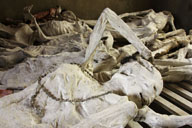
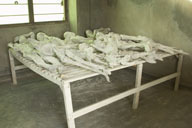
Caption: A rosary symbolizes the betrayal of almost 50,000 people who sought refuge in a church, only to be betrayed by the bishop offering them shelter.
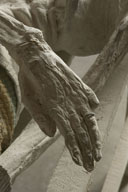
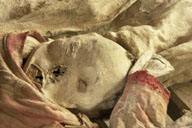
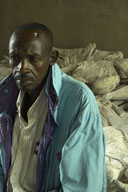
Caption: A wedding band, a doll-like face, a survivor ... images from a genocide memorial. The man was one of only four survivors, shot in the head and left for dead. The bullet still lies lodged somewhere in his brain. He tends the memorial as a testament to his family, lost in the slaughter.
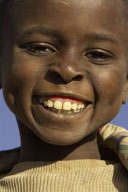
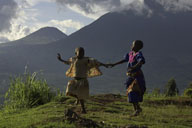
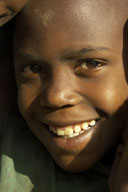
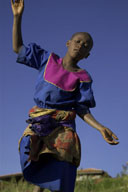
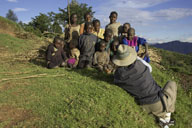
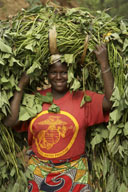
Caption: At the end of all of our trips we always share our 'Trip Highlight,' favorite photos, and other questions. Not surprisingly at all, most people felt 'THE PEOPLE' were as much of a highlight as were the gorillas. Our afternoons, after returning from our morning gorilla treks, were spent traveling the countryside and stopping to talk with, and to photograph, the Rwandan people we met. They were moving, fun, exceptional experiences.